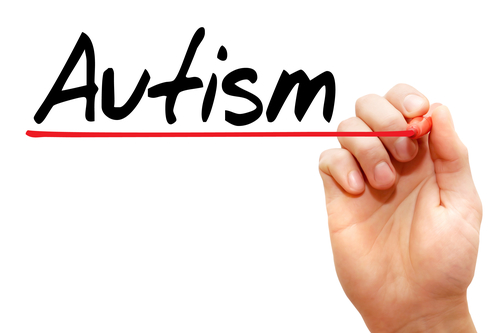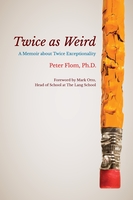What is the “autism spectrum”?
Lately you hear a lot about the autism spectrum. People say things like “he’s not autistic but he’s on the spectrum”. Just what is the autism spectrum?
Back when I was getting my MA in education, “autism” meant a very specific type of syndrome – think “Rain Man”. People with autism were highly unusual and very limited. Nowadays, people with a wide variety of problems, and a wide variety of levels of problem, are called some variety of “autism”. There’s “high functioning autism” and the new DSM may move Asperger’s Syndrome to the autism spectrum, and my own disability (Nonverbal Learning Disability) may belong on the spectrum, depending on whom you ask. I’ve even used the term myself.
What is a spectrum, anyway?
The most famous use of the word “spectrum” is probably the color spectrum, which is usually given as red, orange, yellow, green, blue, violet. Here, place on the spectrum is determined by wavelength. If you know the wavelength of a color, you know exactly where it goes on the spectrum, and the order of the spectrum is determined by only one characteristic. Of course, the spectrum does not fully describe a color – there are many colors at each particular wavelength. To fully describe a color you need three attributes – you can use hue, saturation and value (HSV), or RGB ; or other methods. But it’s not just one dimension.
We also talk about the spectrum of political beliefs, which is surely more complex than color, but, at least in the USA, there is a liberal-conservative spectrum, and some political scientists think that this one dimension nearly fully describes the positions of congressmembers (see this site on VoteView ).
Why “autism spectrum” is misleading
Given that, it’s clear that “spectrum” implies a high degree of order, probably on a single attribute. But the autism spectrum is not like this! The science dictionary defines it thus:
A developmental disorder characterized by severe deficits in social interaction and communication and by abnormal behavior patterns, such as the repetition of specific movements or a tendency to focus on certain objects. Autism is evident in the first years of life. Its cause is unknown. (See halfway down the page here). And the autism spectrum includes that, plus Asperger’s, plus “pervasive developmental disorder not otherwise specified” – the infamous PDD-NOS, which seems to me to mean “something’s wrong here, but we don’t know what!”.
How to put people on a spectrum? If someone has severe deficits socially, but communicates halfway OK in some situations, and has no specific movements, is he farther along the spectrum than someone who has moderate social deficits but has a lot of repetition of movement? What if one of the people hyperfocuses and the other doesn’t? Who knows! That’s because it’s not a spectrum.
Psychologists and others probably like ‘spectrum’. It sounds like science, and it implies that they know what they are talking about. Maybe some of these psychologists have what has been called “physics envy” . I think that’s all wrongheaded. Psychology isn’t physics, and physics isn’t psychology. Psychologists shouldn’t try to be like physicists, they should try to be better psychologists.
It’s more like an autism ballpark
For all the research that’s been done (and it’s been very valuable) we are still in the infancy of learning about autism and related syndromes. I really doubt that “spectrum” will ever be appropriate – psychology is too complex – but it certainly isn’t appropriate now. So, what term should we use?
Ballpark! Look at a baseball field. There’s a center, and then it spreads out in all directions. Then we could say that a person with all the symptoms of classic autism is (say) standing on second base, in the middle of the field. Other people might be out in left field, or on the pitcher’s mound, or anywhere else. Take me. I’ve got some symptoms of autism, some symptoms of Asperger’s some symptoms of NLD; I have a 100% diagnosis of being me. Maybe I don’t belong on the autism spectrum, but I am in the ballpark!
(By the way, the classic definition of NLD includes a lack of sense of humor. If you think that I think that’s sort of silly – well, you’re in the ballpark!)




Peter, while I agree with you as a scientist, I think things look very different from the average person’s perspective.
The colloquial use of the expression “In the ball park” conveys a different meaning, having to do with being “close enough to the norm.”
When your average person contemplates a spectrum, they see a lot of different colors, all grouped together under a single label. While they may be aware of wavelengths, it isn’t part of the basic perception of the spectrum. And while the term doesn’t convey the complex intersection of the sum of one’s position on many “normal” distributions (n dimensional space), it still effectively conveys the most important concept of variability.
“Spectrum” is fine given, I suggest, the right understanding.
It’s not so much that each individual is “somewhere” on the autistic spectrum (though that has advantages over thinking of there being two or three step “types” of autism). Rather, it’s much more that each individual is on many different places on the spectrum at the same time for each different personal trait, strength, skill ability or difficulty.
This is where the very spiky ability profile in autism that so surprises people can be found, and why it’s very rare for any of us to fit into tidy pigeon-holes. My language skills happen to be excellent. My major blind-spots (and they are) lie elsewhere.
If a different analogy is desired, an autistic profile as a hand of cards might serve. Each card “dealt” may be of almost any value, independent of those adjacent.
Hi Chris
I like ballpark just because this way each person can be at one point in the ballpark. Although a hand of cards is interesting too.
Peter
How about “autism dimension”?
Or “realm” or “zone”?
Most NVLDers have pervasive developmental disorder also. They are “odd”. They have abnormal social and emotional profile. Lack of eye contact is one of the hallmarks of NVLDish PDD. Other is atypicality od interests, which makes them authentic, non-kanneric aspies also. They also have emotional nad sensory issues. Their problem is not only in visual-spatial-motor area. Most people with NVLD according to me have to be named as having PDD/ASD/AS.
I think that the largest problem with NVLD is its name. It can be very misleading. Many people with NLD, who have really serious problems with nonverbal communication (such as very poor eye contact, “stupid” facial expression) – very problematic developmental dyssemia, have atypical interests and rituals, troubles with emotional reactions (such as very inappriopiate laughing) appear to have something much more “psychiatric” than just a learning disability or communication disorder. They may have stereotyped behaviors and sensory problems. They appear to receive the diagnosis of Asperger’s very often… It is not improper diagnosis. People with AS diagnosis are really different in cognitive area. Some may have very good visual thinking and poor verbal, other very good verbal and poor visual. NLD is often just an one of milder forms of F84.5 from ICD-10. They have too much similarities to individuals with more severe conditions (such as profound Asperger’s or HFA) to be not recognised as having PDD or autistic “spectrum” disorder. Some forms of “NLD” are too “weird” to be not a PDD and “soft” autism.
There is no term “pervasive developmental disorder” in DSM-V.
The definition of PDD in ICD-10 is too much about “restrictiveness” and “repetitiveness”. I think that many cases of NVLD have to be categrorized in the same group of disabilities as “kanneric” autism, not as a “specific developmental disorder”, “specific learning disability”.
Some forms of NVLD may be rather developmental socio-emotional disabilities, such as classical autism, which is more severe type od “complex” developmental disorder.
NVLD is a complex (not specific!) developmental disorder. It can bring all of them: social, emotional, behavioral issues, idiosyncratic thinking, sensory integration issues. NVLD is misnamed and misclasified. NVLD, such as “kanneric” autism, is a complex developmental disorder.
Some complex developmental disorders:
– classic autism (spectrum) – rather severe to profound
– “nonverbal learning disorder” (spectrum?, current term too misleading, not all cases of NVLD give socio-emotional disability) – rather mild to moderate
– multiple-complex developmental disorder – may be severe
– pathological demand avoidance syndrome – not very severe
– Rett’s syndrome – rather profound
– childhood disintegrative disorder – rather profound
The name “NLD” HAS to be changed. It misleads definately. I am talented in scholastic abilities, but have weird socio-emotional-behavioral symptoms. I probably have NLD profile. I have AS diagnosis, but I think that in Northern America I would be diagnosed with NLD, but not with AS(D)/PDD. It is psychiatric problem in my case, not learning disorder.
NLD is not an official diagnosis here either; and we are stuck with the name, as far as I can see
I do not accept the name NLD when it is used tosomething which gives marked social ineptitude and “idiosyncratic” emotionality and behaviors. I think that in America I would receive the diagnosis of NLD, but my problems were rather due to “idiosyncratic mind”. I am rather a verbal thinker, but like maps, colors, handwriting… Im my opinion have a pervasive developmental disorder (which I have diagnosed), not a learning disorder as my most important mental health problem. I also think that many people with PDD are misdiagnosed as just NLDers. I have bizarre emotionality, social needs and behaviors. I have social communication problems, especially in nonverbal area, which are often named as NLD symptoms. Names such as “autistic”, “schizotypal”, “PDD” looks “serious”, but the name “learning disorder” do not look serious for me, it is associated with something that has not (so) pervasive influence on someone’s mentality, especially LD is not something which makes someone idiosyncratic.
So I said I’d look at this and … actually, I’m not convinced that the null hypothesis (that ‘spectrum’ is the best word to use) can be sensibly retained.
Slightly iconoclastic notion, but I actually find that this concept works bettwe than the ‘spectrum’ concept does.
The autism scatterplot, maybe?
I think of it more of a dart-board, with neurotypicals in the centre region, and neurodiverse (including those on the ASD spectrum) everywhere else. Of course, reality is even more complex than that, but at least it conveys the idea that it is not just a simple linear range going from high-functioning to low-functioning.
My problem with the wordspectrum is that it is continuous. I, as a parent of a relevant child, am continuously told by well–meaning professionals that this means the absence of a theory of mind. Absence and presence form a dichotomy.
Oh well, perhaps that is am argument FOR to counter the TOM assumption. I certtainly favour something continuous.
Ball parks have a definite boundary between spectators and players. That may be unfortunate in the TOM argument.